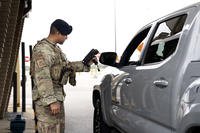JOINT BASE SAN ANTONIO - LACKLAND, Texas -- Visionaries at 25th Air Force are merging advances in technology with innovation and creative thinking to revolutionize how Airmen are educated, trained and developed in the intelligence community.
Their competency and proficiency based approach does not involve sleight of hand, but it is MAGIC.
The eyebrow-raising acronym stands for Mobile Apps & Games for Intelligence Courses, which marries state-of-the-art presentation technology with graphics, text, voice, video, sound effects and animation to create effective, engaging learning experiences.
"We found there was a need to more effectively reach our target student population," said Frank von Heiland, the chief of the Force Development and Training Division and Senior Language Authority for 25th Air Force. "A lot of research was done to ensure this approach was right, including some very sophisticated peer research."
Of the approximately 12,000 Air Force enlisted intelligence professionals, 70 percent of those Airmen have less than five years of service, and are millennials. MAGIC's premise centers on game-based learning (serious games), targeting the training needs of the millennial generation, coupled with mobile learning (m-learning).
"Another factor that drove the need is the migration of Air Force Special Operations Command Airmen to electronic flight books," von Heiland said. "This meant our 361st Intelligence, Surveillance and Reconnaissance Group Airmen would all be carrying iPads on their missions."
This 'gamification' teaching method enables instructors to challenge Airmen with realistic scenarios that require students to employ detailed analysis and problem-solving skills to meet specific learning goals and objectives.
The unique technique leverages simulation technologies with immersive learning, enabling trainees to re-enact exact circumstances multiple times, reviewing the consequences of different actions. This gives a more in-depth learning experience, the important takeaways of which are improved retention and critical thinking skills.
MAGIC gives students more training time to practice and apply what they've learned instead of sitting through instructor-led training in a classroom.
"We started two years ago by taking the Air Education and Training Command approved curriculum for the Airborne Cryptologic Operator Course at Goodfellow Air Force Base, Texas, including materials for very complex subjects like electromagnetic wave propagation, network fundamentals, radio wave propagation and super heterodyne multiplexing and converted them from PowerPoint and text presentations to fully interactive apps and games for students," von Heiland said.
The m-learning aspect of MAGIC literally plays into the hands of today's ISR-focused Airmen.
Mobile learning affords self-directed Airmen access to information via their smart phones or tablets around the clock, fostering a more conducive learning atmosphere.
The ability to access learning anytime, anywhere through distributed mobile learning is a methodology the Air Force is increasingly looking into. Successful implementation of MAGIC is seen by young intelligence professionals as the direction their training is headed.
"The feedback we're getting from Airmen is that this is the delivery method of the future for intelligence education and training, and they want more every day," von Heiland said.
This capability mirrors the 25th Air Force education and training vision for the intelligence professional, "to develop and maintain skilled ISR analysts and operators capable of meeting the challenges of operational adaptability in an era of persistent, complex, conflict and change."
Besides its accessibility upside, MAGIC utilizes a more adaptable and instructional design, creating training that's more operationally relevant and individually tailored.
MAGIC proponents see this modern approach as a 'game' changer in the way education and training is delivered to intelligence professionals, better positioning them to meet the ever-changing landscape of warfare.


























